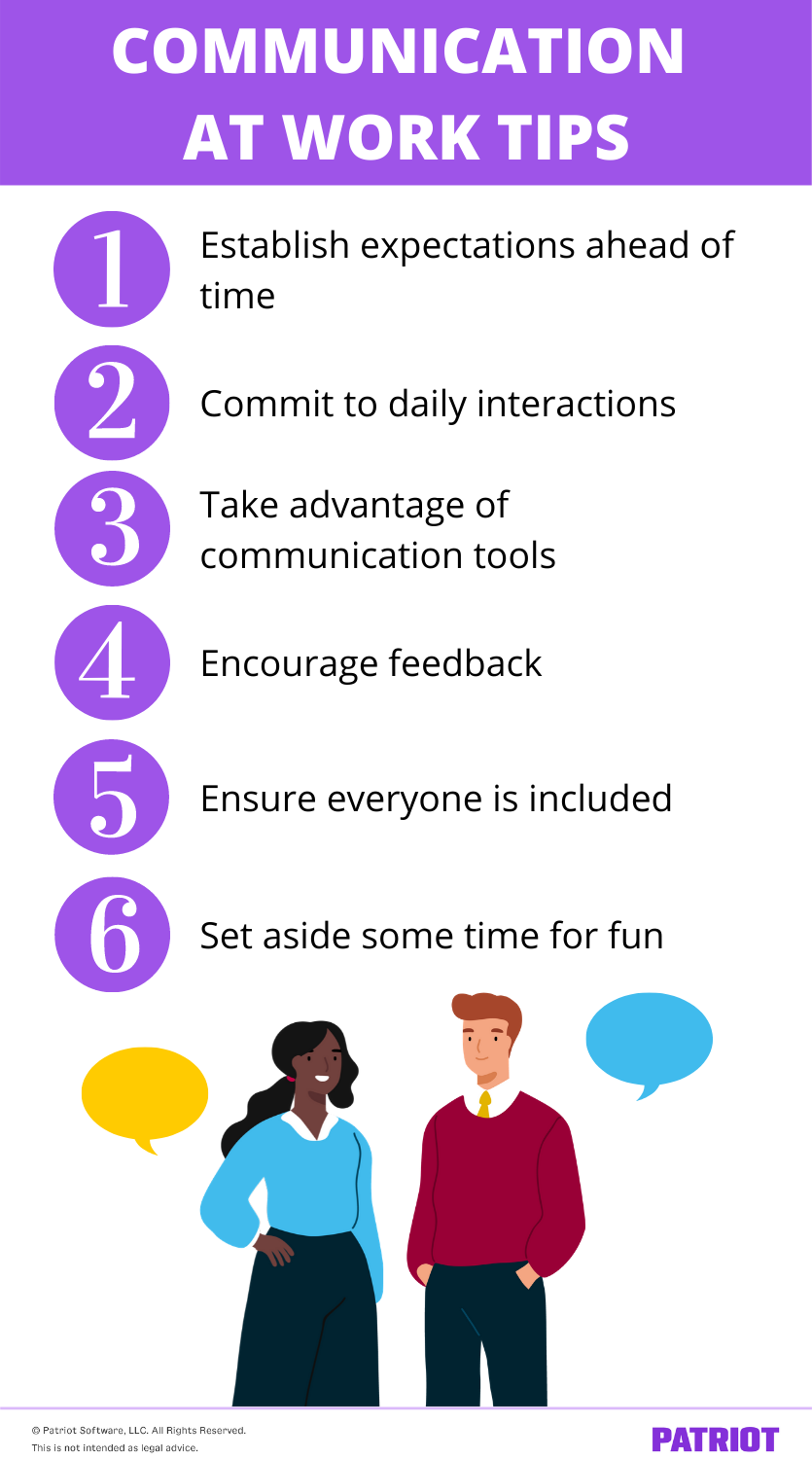In the matter of a few weeks, the percentage of remote workers doubled from 31% to 62%, thanks to the coronavirus outbreak. Maybe your team was already used to working from home before COVID-19 struck. Or, maybe your business is gearing up for 100% remote work for the post-pandemic era. Whatever the case may be, effective and clear communication at work (remote and in the office) is a must.
Communication at work: 6 Tips
The way your company communicates can make or break your business. Strong communication can boost productivity and help your business thrive in any environment (aka remotely). In fact, one study shows that productivity can increase by up to 25% when employees are connected.
In addition to improving productivity levels, having open and clear remote team communication can:
- Strengthen your team
- Enhance innovation
- Build a positive workplace culture
- Increase employee morale
- Grow employees into leaders
On the importance of communication at work, Ben Aston, Founder of The Digital Project Manager, said:
You are only as good as your team. Clear and continuous freeflow of communication is necessary to facilitate ideas from beginning to final product. It’s a building block that your team requires to complete any project. Without it, your progress comes to a halt and your organization is held back from innovation.
Paul French, founding Director of Intrinsic Executive Search, also advises:
Workplace communication has a significant influence on an organization’s growth trajectory. In organizations that value proper communication, there is a notable decrease in turnover rates and absenteeism and a spike in employee satisfaction. An organizational culture that upholds strong verbal and non-verbal communication also enables easier entry into global marketplaces.
If your remote team is struggling when it comes to communicating, what are you waiting for? Use these six remote work communication tips to get your virtual team engaged and connected in no time.

1. Establish expectations ahead of time
Before your team goes fully or partially remote, you need to outline your work from home expectations from the get-go. That way, you can ensure a smoother transition into a work from home setting (even if it’s only temporary) and jump over any hurdles more quickly. Establishing your expectations sooner rather than later also helps keep employees on the same page about communicating throughout the remote work day.
To help with the transition and keep communication strong, consider creating a work from home policy for your employees. Your policy should list the following details:
- Eligibility for remote work
- Performance expectations
- Disciplinary actions if guidelines aren’t followed
- Check-in times (e.g., meetings, one-on-ones, etc.)
- Appropriate work hours (e.g., 7 a.m. – 7 p.m.)
- Communication guidelines (e.g., using Slack for chatting)
- Other rules (e.g., being in a distraction-free environment)
If you opt to implement a work from home policy, have your employees sign it, and keep the signed copies in your records. Include a copy of your policy in your employee handbook for easy access.
2. Commit to daily interactions
When it comes to remote work, sometimes emails and chats just don’t cut it. If you want to have strong communication with your team while remote, consider committing to daily virtual “face-to-face” interactions.
To communicate with your team, include one (or more) of the following in your remote team routine:
- Morning “standup” meetings or huddles
- One-on-ones with employees weekly
- Mini meetings
Try to communicate with your remote team via video conferencing at least once per day to ensure they are up to speed and connected with each other. Encourage your team to communicate with one another over video calls to discuss projects and ideas, too.
Whatever you decide to do, commit to a schedule for communicating face-to-face virtually (e.g., standups each morning at 9 a.m.). Doing so keeps everyone in the loop and communicating regularly.
3. Take advantage of communication tools
You can’t expect remote employees to effectively communicate if they’re not given the tools to do so.
In a remote environment, you need much more than your typical chat channels and email accounts. And if you want employees to be productive and collaborate, you need to embrace new communication tools. Some tools you may consider for your business include a video conferencing application (e.g., Zoom), project management software, employee recognition software, cloud storage service (e.g., Google Drive), and a time management tool.
If you’re on the hunt for some new virtual communication tools, consider what your company truly needs. Do your employees juggle a lot of projects? If so, consider investing in project management software so they can track their various projects and monitor progress. Weigh the pros and cons and get input from your employees before deciding on a new tool.
4. Encourage feedback
When you have performance reviews for employees, you give them feedback. But feedback isn’t just important during performance review season. It’s also necessary when it comes to communicating with your team.
If you want to have top-notch communication on your team, be open to feedback from employees. Use feedback to your advantage to improve the way your team communicates with each other. Plus, you can use feedback from employees to figure out what is and is not working for your remote team.
When receiving feedback, listen to what your team has to say. If they’re struggling to communicate or utilize the tools you currently have in place, find a solution to improve the situation and make communication easier moving forward.
5. Ensure everyone is included
Part of keeping communication strong on your team is ensuring that every single employee is included when it comes to team-building activities, projects, and other tasks. But, sometimes this can be challenging if part or all of your team is remote during the week.
To make sure all employees are involved, regardless of if they’re in the office or working from home, schedule meetings at a convenient time for everybody, recognize all employees’ achievements and contributions, and utilize communication tools (cough cough, tip number three).
Including all employees not only enhances your communication in the workplace, but also improves your workplace culture and can help you retain top talent.
6. Set aside some time for fun
Last but not least, don’t forget to ensure employees have some fun throughout their virtual workweek!
Communication doesn’t always have to be work related 24/7. And if you want to improve productivity and increase employee engagement, employees have to take a well-deserved break every once in a while.
You can spend some time team building and connecting with your co-workers by:
- Having a digital coffee break
- Hosting a virtual lunch
- Getting together for a virtual show and tell
Digital watercooler chitchat may seem silly, but casual conversations can help improve team communication just as much as serious work discussions do. So, don’t be afraid to set aside some time to kick back, relax, and connect with your team!
